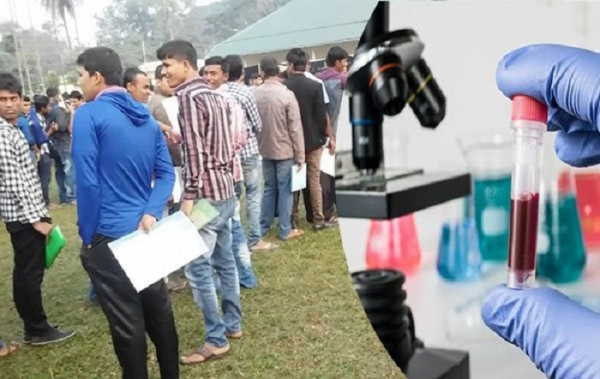the thalassemic people are more resistant plasmodium of the disease, so they are favored by evolutionary point of view.
If we consider the geographical distribution of the hematological disease, in fact, it can be seen that it is similar to that of the infection transmitted by mosquitoes .
The reason is due to structural changes and shorter life of erythrocytes in thalassemics, as well as in patients suffering from other hemoglobinopathies (eg sickle cell disease ). These characteristics prevent the exploitation of red blood cells by the malaria plasmodium , which thus fails to complete its reproductive cycle.
Malaria is a disease caused by parasites of the genus Plasmodium . According to the WHO, this disease causes around one million victims a year in the world. About 40% of the world’s population is exposed to the disease and 500 million clinical cases are observed each year. The situation is all the more worrying because for several years parasites have been developing resistance to antimalarial drugs and mosquitoes are less and less afraid of insecticides. Today, no vaccine is available.
cause
Malaria is a life-threatening infectious disease caused by several species of parasites belonging to the genus Plasmodium. The parasite is transmitted to humans by the bite of infected mosquitoes. These mosquitoes, “vectors” of malaria, all belong to the genus Anopheles .
SYMPTOMS
The clinical manifestations of malaria are very diverse. Malaria begins with a fever 8 to 30 days after infection, which may or may not be accompanied by headache , muscle aches , weakness , vomiting , diarrhea , coughing . Typical cycles alternating fever, tremor with cold sweats and intense sweating, can then occur: it is ” access palustral “. The periodicity of these cycles depends on the species of parasite involved, and coincides with the multiplication of parasites and the bursting of red blood cells, which also leads to anemia . Malaria caused byP. falciparum can be fatal if not treated. In some cases, infected red blood cells can clog blood vessels irrigating the brain: this is the neuropaludism , often fatal.
In areas where malaria is highly endemic, part of the population is asymptomatic. Following many years of chronic infection with the parasite, some individuals tolerate its presence and develop a natural immunity (“acquired immunity”).
Epidemiology
Malaria affects some 100 countries worldwide, particularly the less-favored tropical areas of Africa, Asia and Latin America. The Africa is by far the most affected continent with 90% of cases of malaria recorded in its tropical areas. Epidemics can occur during movements of populations with little exposure to malaria to highly endemic areas.
The Europe known cases of so-called imported malaria. In France , in 2011, 3560 import cases were reported (source InVS).
The different species of plasmodium parasite involved
Four species of parasites of the genus Plasmodium are responsible for the disease in humans:
Plasmodium falciparum is the most pathogenic species and responsible for fatal cases. It is present in the tropical zones of Africa, Latin America and Asia, and is dominant in Africa;
Plasmodium vivax co-exists with Plasmodium falciparum in many parts of the world, and is present in some temperate regions;
Plasmodium ovale , mainly found in West Africa, does not kill but can cause relapses 4 to 5 years after the first infection;
Plasmodium malariae has a worldwide distribution but very uneven. It is not deadly but can cause relapses until 20 years after the first infection.
Transmission
Malaria is transmitted to the man by the bite of a female mosquito , of the genus Anopheles, itself infected after having stung a malarial man: the female, taking the blood meal necessary for its oviposition, injects the parasite into his host. Males do not sting.
The transmission of Plasmodium from one man to another is therefore via the mosquito, the main cause being Anopheles gambiae on the African continent. There is only one case of direct inter-human contamination, when an infected pregnant woman contaminates her child transplacental .
Parasite cycle
The Plasmodium cycle is complex and involves two essential stages: an asexual phase in humans, and a sexual phase in mosquitoes.
The female anopheles injects the parasite into the form of a ” sporozoite “. It migrates quickly through the bloodstream to the liver. It enters the liver cell, where it divides very actively to give birth, in a few days, to tens of thousands of new parasites: the ” merozoites “. The liver cell bursts by releasing these parasites into the blood: there, they penetrate inside the red blood cells and multiply. When they break out, the merozoites released into the bloodstream infect new red blood cells (erythrocyte cycle).
After a few cycles of merozoite replication, male and female sex parasites (gametocytes) are formed inside the red blood cells. When a mosquito bites an infected person, it ingests these gametocytes, which turn into gametes . Their fertilization generates a zygote , which differentiates itself into an oocyst in the digestive tract of the mosquito. Oocysts produce sporozoites, which migrate to the salivary glands of the mosquito . A new cycle can then begin.
The late relapses of malaria observed during infections with P. vivax and P. ovale are due to the possibility for these species to subsist in a latent form (“hypnozoite”) in the liver cell of man.
Prevention and treatments
Several anti-malarial molecules that can be used in prophylaxis (prevention during a trip in endemic zone) or in therapeutics . The best known are chloroquine or quinine . Others, such as mefloquine, are used in areas with chloroquine-resistant parasites .
Highly recommended preventive treatment
It is dangerous to leave in an area of intense malaria transmission without regular preventive treatment, especially for children and pregnant women who have an increased risk of severe access. Preventive treatment must be prescribed by a doctor . It takes into account the zones visited (risk, existence or not of resistance), the duration of the trip and also the person: the age, the pathological antecedents, an intolerance to antimalarials, a possible drug interaction, a pregnancy.
But anti-malarial drugs do not guarantee absolute protection against infection and it is also important to protect yourself from mosquito bites (mosquito nets, mosquito repellent).
No preventive means alone provides total protection and, even if appropriate treatment has been taken, it is possible to have a malaria attack, sometimes of late onset. The first symptoms are often not very alarming, but malaria can be fatal if treatment is delayed. Also, in case of even slight fever, nausea, headache, body aches or fatigue during the stay or in the months following the return, a doctor must be consulted urgently . Taking a blood sample is necessary to confirm the diagnosis. Any fever at the return of the tropics must be regarded a priori as malaria until proven otherwise.
Search for a vaccine
Today, no vaccine is available to fight malaria. At the Institut Pasteur, several teams are working on the development of vaccines against malaria and several candidates are under study.
A delicate focus
One of the major difficulties in developing a vaccine against Plasmodium is that during its life, the parasite passes successively through several stages with phases of intense asexual multiplication in humans (in liver cells – hepatic phase – then in red blood cells – erythrocyte phase – and a phase of sexual reproduction followed by multiplication, in the insect. Each stage ends with the release of a parasite of a different form , thus carrying different antigens and inducing different immune responses, which complicates the search for a vaccine.
At the Institut Pasteur
Many Institut Pasteur teams are dedicated to malaria research. In addition to vaccine research, several teams are carrying out more fundamental research on both humans and the parasite Plasmodium and its vector, the Anopheles mosquito . Such research is essential if, in the long run, we want to find new ways to combat malaria.
In addition, the Institut Pasteur is part of a major European program, called EVIMalaR, which brings together 17 research institutes or universities from 7 European countries and partners in 3 African countries (Mali, Sudan, Uganda). The objective of this program is to deepen the basic knowledge of the parasite responsible for the disease, mosquito vectors, as well as the biology of interactions between different hosts (vectors and mammals) and the parasite.
Four years to develop a new antimalarial candidate
One of the obstacles in the fight against malaria is the resistance of Plasmodium parasites to current drugs. Faced with a potential therapeutic impasse, new molecules must today be developed to prepare the drugs of tomorrow.
This is the subject of the project “Malaria Proteases Inhibition” (MaPI) coordinated by Jean-Christophe Barale. Started in 2012, MaPI is based on the validation of two new therapeutic targets, the SUB1 and SUB2 proteins, necessary for the parasite to enter and exit liver cells and red blood cells in humans.
Supported by funding from the National Agency for Research (ANR), MaPI involves several teams from Pasteur Institutes in Paris and Cambodia, as well as an industrial partner, Sanofi. The main objective of the project is, during the next four years, to identify and optimize a SUB1 and / or SUB2 inhibitor via an integrated and multi-disciplinary approach based on repeated cycles of synthesis and biological evaluations. The aim is thus to define a new antimalarial candidate likely to enter the clinical evaluation phase.




















